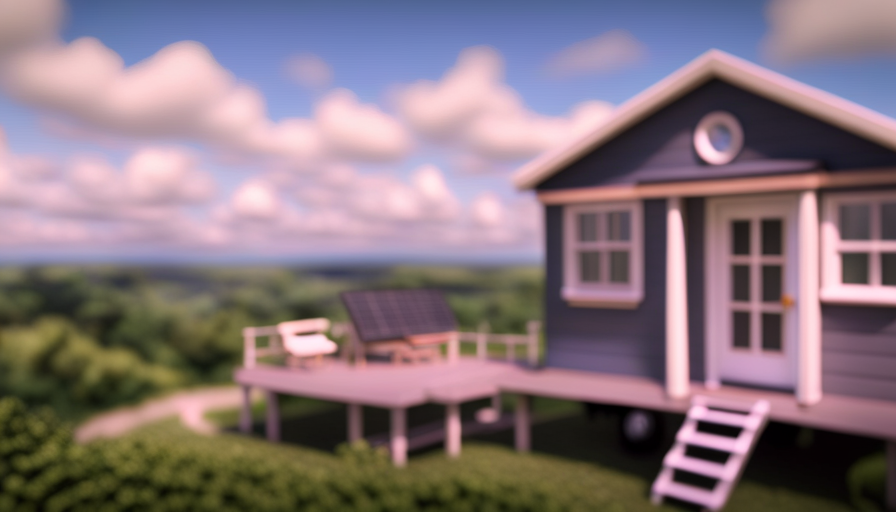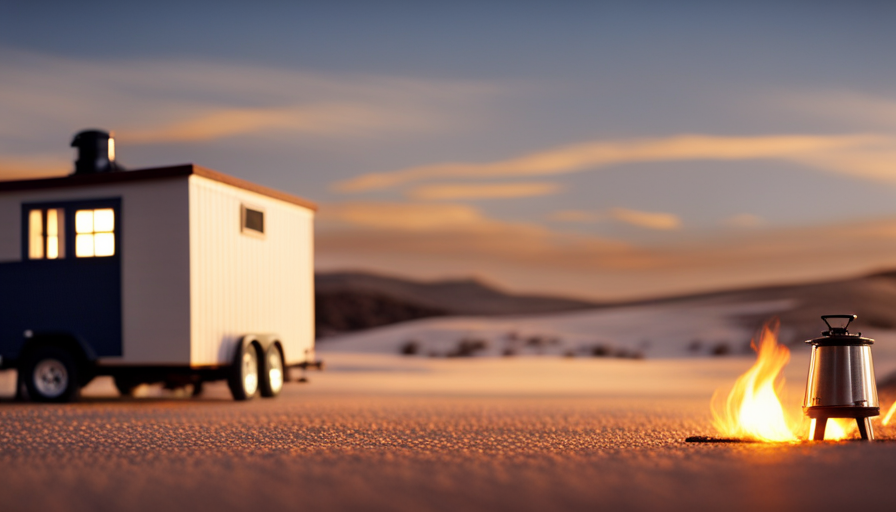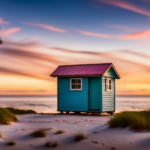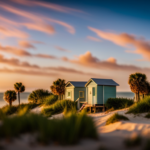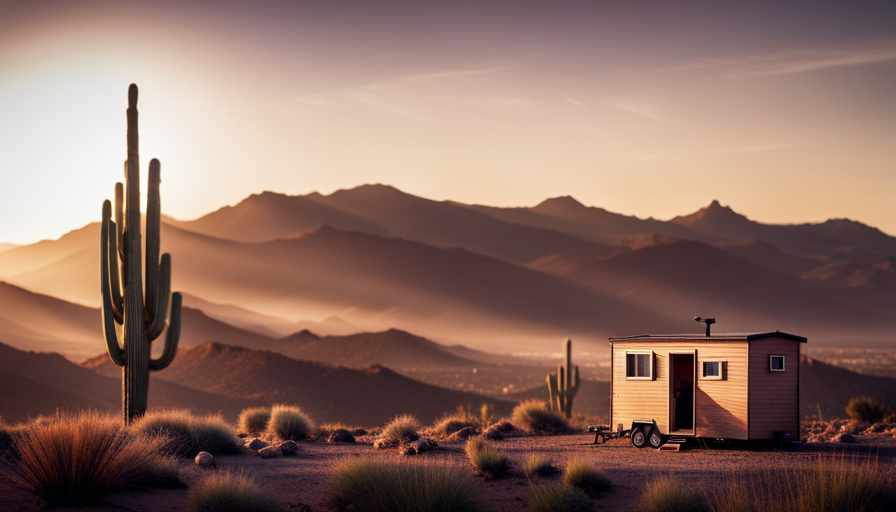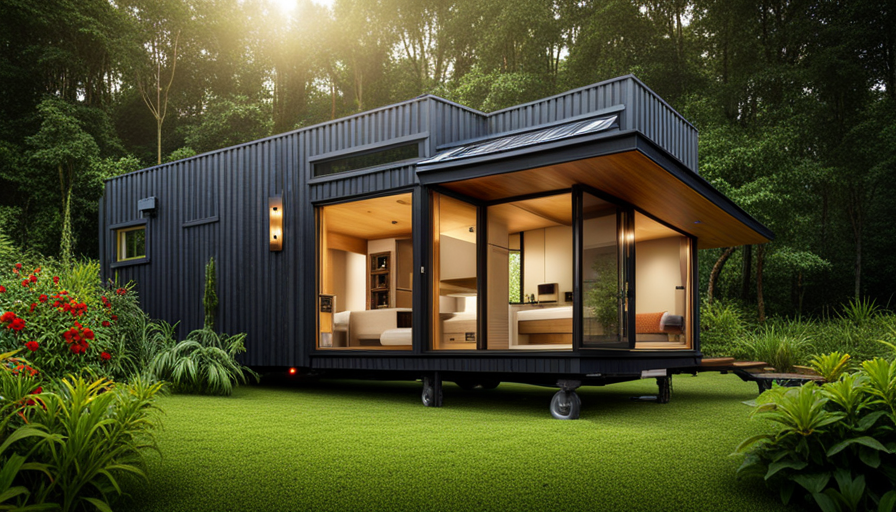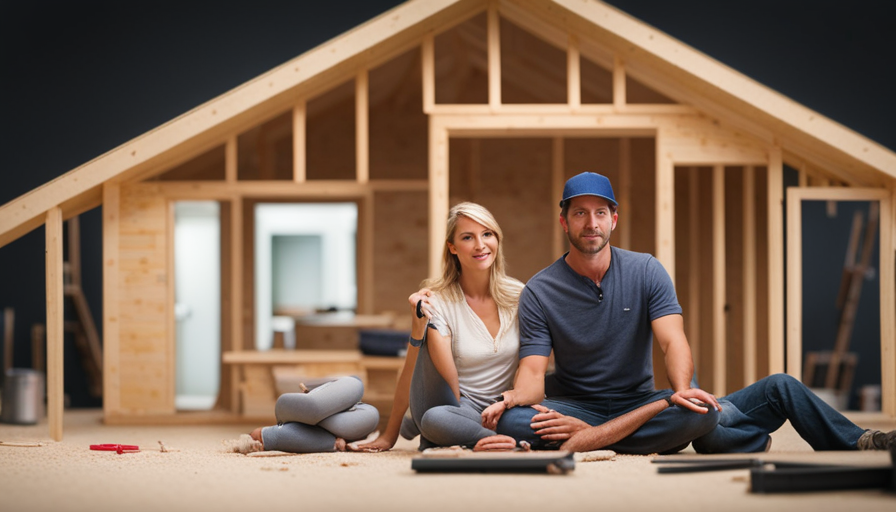In the realm where the sun beams and beaches are lined with pristine sand, under the gentle sway of palm trees and the soft murmur of the ocean breeze, you’ll find the captivating state of Florida. However, amid its charm and magnetic appeal, a novel trend has surfaced – the tiny house movement.
These whimsical abodes, with their compact size and minimalist charm, have captured the hearts and imaginations of many Floridians looking to downsize and simplify their lives. However, before embarking on this unique adventure, one must consider the all-important question: How much does it cost to build a tiny house in Florida?
In this article, I will delve into the intricacies of building a tiny house in the Sunshine State, exploring everything from local building codes to material costs and labor expenses. By the end, you will have a comprehensive understanding of the financial aspects involved, allowing you to embark on your tiny house journey with confidence and clarity.
So, let us embark on this exciting exploration together, as we uncover the true cost of building a tiny house in Florida.
Key Takeaways
- Research local building codes, zoning restrictions, and permit requirements in Florida
- Calculate material costs and consider quality, durability, and sustainability of materials
- Factor in expenses for land, foundation, interior and exterior finishes, and off-grid or sustainable features
- Evaluate maintenance and insurance costs, and compare quotes from contractors and suppliers
Research Local Building Codes and Regulations
You’ll need to research the local building codes and regulations in Florida to make sure your tiny house dream doesn’t get crushed by red tape and restrictions. Before you start building your tiny house, it’s essential to understand the zoning restrictions and building permits required in your specific area.
Each county and city in Florida may have different regulations, so it’s important to do your due diligence.
Zoning restrictions in Florida can vary greatly, and they dictate where you can legally place your tiny house. Some areas may have specific zoning requirements for tiny houses, while others may classify them as accessory dwelling units or require them to be on wheels. It’s crucial to check with your local zoning department to ensure compliance with the regulations.
Obtaining building permits is another critical step in the process. These permits ensure that your tiny house meets all safety and structural requirements. Building codes in Florida are designed to protect homeowners and ensure their safety. It’s crucial to familiarize yourself with these codes and obtain the necessary permits before starting construction.
Once you have thoroughly researched the local building codes and regulations, you can move on to determining your design and layout for your tiny house. By understanding the restrictions and requirements, you can tailor your plans to comply with the rules while still creating the tiny house of your dreams.
Determine Your Design and Layout
Imagine yourself sitting in the cozy nook of your very own sunshine-filled sanctuary, where every corner of your dream abode has been carefully designed and laid out to reflect your unique personality and needs. When determining the design and layout of your tiny house in Florida, it’s essential to consider space optimization techniques and incorporate unique storage solutions that’ll make the most of your limited square footage.
To paint a picture of what this could look like, consider the following:
-
Utilize multipurpose furniture: Opt for a sofa that can be converted into a bed, or a dining table that can be folded away when not in use. This’ll maximize your living space and allow for flexibility in how you use each area.
-
Built-in storage: Incorporate built-in shelves, cabinets, and closets to maximize vertical space and keep your belongings organized. Consider utilizing under-stair storage or creating storage compartments within your furniture.
-
Creative use of walls: Install hooks, shelves, or magnetic strips on the walls to hang and store items such as utensils, pots, and pans, or even shoes.
By implementing these space optimization techniques and incorporating unique storage solutions into your tiny house design, you can create a functional and personalized living space. This’ll not only reflect your needs and personality but also make the most of the limited square footage available.
In the next section, we’ll explore how to calculate the material costs for your project.
Transitioning into the subsequent section about calculating material costs, it’s important to consider the financial aspect of building your tiny house in Florida.
Calculate Material Costs
To accurately estimate the expenses involved in constructing your compact dwelling in the Sunshine State, it’s crucial to diligently calculate the costs of the materials required for your project.
Calculating costs and sourcing materials are essential steps in the process of building a tiny house in Florida. The first step is to determine the quantity of each material needed, such as lumber, insulation, roofing materials, and siding.
Once you have a comprehensive list, you can start researching prices from various suppliers to find the best deals. When calculating material costs, it’s important to consider factors such as quality, durability, and sustainability. While it may be tempting to go for the cheapest option, investing in high-quality materials will ensure the longevity and efficiency of your tiny house. Additionally, considering eco-friendly alternatives can contribute to a more sustainable and energy-efficient dwelling.
Sourcing materials can be done through local suppliers or online platforms that specialize in tiny house construction. It’s recommended to compare prices and read reviews to ensure you’re getting the best value for your money. Don’t forget to account for delivery fees if you choose to purchase materials from different locations.
By thoroughly calculating material costs and sourcing the necessary materials, you can have a clearer picture of the financial aspect of building a tiny house in Florida. With this information, you can now transition to estimating labor expenses to have a comprehensive understanding of the overall project costs.
Estimate Labor Expenses
Now, buckle up because estimating the labor expenses for your pint-sized masterpiece is going to be a wild ride! Finding skilled contractors is the first step in ensuring the success of your tiny house project. Look for contractors who specialize in building small homes or have experience in carpentry and construction. Ask for recommendations from friends, family, or local builders’ associations.
Obtaining necessary permits is another crucial aspect of the labor expenses. Contact your local building department to understand the specific permits required for your tiny house, such as building permits, electrical permits, and plumbing permits. Keep in mind that permit costs vary depending on the location and size of your tiny house.
To estimate labor expenses accurately, consider the following factors:
- Complexity of the design: Intricate designs may require more skilled labor, leading to higher costs.nn2. Materials used: Labor costs can vary based on the type of materials used, such as wood, metal, or eco-friendly alternatives.nn3. Timeframe: If you need the project completed quickly, it may require additional labor or overtime expenses.nn4. Location: Labor costs can differ based on the local market rates and availability of skilled workers.
Once you have estimated the labor expenses, it’s important to consider additional costs for utilities and permits. These costs can significantly impact your overall budget and should not be overlooked.
Transitioning into the subsequent section about ‘consider additional costs for utilities and permits,’ it is essential to thoroughly research and plan for these expenses to avoid any unexpected surprises during the construction process.
Consider Additional Costs for Utilities and Permits
Picture yourself in the midst of your tiny house project, envisioning the additional expenses for utilities and permits that are crucial to consider for a smooth construction process. When calculating the cost of building a tiny house in Florida, it’s important to take into account the cost of living in the area, as it can have a significant impact on property value and thus affect the overall cost of your project. In Florida, the cost of living can vary depending on the specific location, so it’s essential to research and understand the local market trends.
Additionally, you should factor in the cost of utilities such as water, electricity, and sewage. These costs can vary depending on the size of your tiny house and the specific utility rates in your area. It’s important to contact the local utility providers to get accurate estimates for these expenses.
Moreover, permits are another expense to consider. Building permits are required for any construction project, including tiny houses. The cost of permits can vary depending on the location and the size of your tiny house. It’s crucial to research the specific permit requirements for your area and budget accordingly.
Considering these additional costs for utilities and permits is essential for an accurate budget for your tiny house project. As we move into the next section about budgeting for land and foundation, it’s important to keep in mind the impact of these expenses on your overall budget.
Budget for Land and Foundation
When considering the cost of building a tiny house in Florida, it’s important to budget for land and foundation expenses. The availability of land plays a significant role in determining the overall cost of your project. In highly sought-after areas, the price of land can be quite high, while more rural locations may offer more affordable options. Additionally, the size and location of the land will also impact the cost.
Another important aspect to consider is the foundation of your tiny house. There are various foundation options to choose from, each with its own cost implications. For example, a traditional concrete foundation may be more expensive than a pier and beam foundation.
By budgeting for land and foundation costs, you can have a more accurate understanding of the overall expenses involved in building a tiny house in Florida. This will allow you to plan your budget accordingly and avoid any unforeseen financial burdens along the way.
Once you have determined the cost of land and foundation, you can then factor in the expenses for interior and exterior finishes.
Transitioning into the next section about ‘factor in interior and exterior finishes,’ it’s crucial to consider these aspects in order to complete your tiny house project successfully.
Factor in Interior and Exterior Finishes
To complete your tiny house project successfully, you’ll need to factor in the expenses for interior and exterior finishes, which can greatly enhance the overall look and functionality of your space. When it comes to choosing finishes, it’s important to consider your personal style, as well as the durability and cost of materials.
Let’s start with the interior finishes. The cost breakdown for interior finishes typically includes flooring, walls, and ceilings. For flooring, you have options like hardwood, laminate, or tile, each with different price points. Similarly, the type of wall finish you choose, such as paint, wallpaper, or paneling, will affect the overall cost. As for the ceilings, options like drywall, wood, or tin can all add character to your tiny house but at varying costs.
Moving on to the exterior finishes, you’ll need to consider the materials for siding, roofing, and windows. Siding choices like vinyl, wood, or metal can have different price ranges, while the type of roofing material you select, such as asphalt shingles or metal panels, will also impact your budget. Additionally, energy-efficient windows might cost more upfront but can save you money in the long run.
To plan for off-grid or sustainable features, you’ll need to consider the cost implications of incorporating solar panels, rainwater harvesting systems, or composting toilets. These features can help reduce your reliance on traditional utilities and minimize your environmental footprint.
When determining the cost of building a tiny house in Florida, it’s important to factor in the expenses for both interior and exterior finishes. By carefully choosing finishes that align with your style and budget, you can create a beautiful and functional space.
Moving forward, let’s explore how to plan for off-grid or sustainable features.
Plan for Off-Grid or Sustainable Features
Let’s dive into how you can incorporate off-grid or sustainable features into your tiny house project. When planning for off-grid features, one key aspect to consider is the power source. Opting for off-grid power solutions such as solar panels or wind turbines can reduce your reliance on traditional electricity sources and lower your energy costs in the long run. Additionally, using sustainable materials throughout your tiny house construction can have a positive impact on the environment and your budget. Look for materials that are renewable, recyclable, and have a low carbon footprint.
To provide a visual representation of the different options available, here is a table showcasing various off-grid power and sustainable material choices:
| Off-Grid Power | Sustainable Materials |
|---|---|
| Solar Panels | Bamboo |
| Wind Turbines | Cork Flooring |
| Hydroelectric Power | Recycled Glass Countertops |
| Biofuel Generators | Reclaimed Wood |
By incorporating off-grid or sustainable features into your tiny house, you can not only reduce your environmental impact but also potentially save money on energy bills and contribute to a more sustainable future. Now, let’s move on to evaluating maintenance and insurance costs for your tiny house project.
Evaluate Maintenance and Insurance Costs
Evaluate the maintenance and insurance costs for your tiny house project and brace yourself for the potential financial burden that comes with it. When building a tiny house in Florida, it’s essential to consider the ongoing maintenance expenses that may arise.
These costs can include regular cleaning, repairs, and replacements for various components such as the roof, siding, plumbing, and electrical systems. Additionally, you may need to allocate funds for landscaping and pest control services to ensure the longevity of your tiny house.
Insurance coverage is another crucial aspect to consider. It’s essential to protect your investment by obtaining adequate insurance coverage for your tiny house. This coverage should include protection against natural disasters, theft, and liability.
Depending on the location and specific features of your tiny house, insurance premiums may vary significantly. It’s advisable to consult with insurance providers specializing in tiny house coverage to determine the most suitable and cost-effective policy for your needs.
Evaluate the maintenance and insurance costs thoroughly to have a clear understanding of the financial responsibilities associated with your tiny house. Once you’ve assessed these expenses, you can confidently move on to the next section and compare quotes from contractors and suppliers, ensuring that you make informed decisions throughout the construction process.
Compare Quotes from Contractors and Suppliers
Once you’ve thoroughly evaluated maintenance and insurance costs, it’s time to gather and compare quotes from contractors and suppliers for your tiny house project in Florida. This step is crucial in determining the overall cost of building your tiny house.
When it comes to choosing between hiring a contractor or doing it yourself (DIY), it’s important to weigh the pros and cons. Hiring a contractor can save you time and ensure a professional finish, but it can also be more expensive. On the other hand, opting for a DIY approach can be cost-effective, but it requires a significant amount of time, effort, and skill.
To get started, reach out to multiple contractors and suppliers in your area and request quotes. Make sure to provide them with detailed plans and specifications for your tiny house. This will allow them to give you accurate estimates.
While comparing quotes, pay attention to the breakdown of costs. Look for any hidden fees or additional charges that may arise during construction. Additionally, consider the reputation and experience of each contractor and supplier. Remember, it’s not just about finding the cheapest option, but also about finding a reliable and trustworthy professional.
To save on costs, consider these cost-saving tips: source materials locally, reuse and repurpose materials whenever possible, and consider alternative construction methods that may be more affordable.
By being thorough and detailed in comparing quotes, you can make an informed decision that suits your budget and needs.
Frequently Asked Questions
What are the average property prices in Florida for building a tiny house?
Average property prices in Florida for building a tiny house vary depending on location and cost factors like materials and labor. Analyzing the market thoroughly is key to determining the overall cost and finding the best deals.
Are there any specific regulations for tiny houses in Florida that I need to be aware of?
There are specific regulations for tiny houses in Florida that I need to be aware of. These include zoning regulations that dictate where and how tiny houses can be built in the state.
How can I find affordable land options for building a tiny house in Florida?
Finding affordable land options for building a tiny house in Florida can be challenging, but there are options. Consider joining tiny house communities, which provide shared land and amenities, making it more cost-effective and fostering a sense of community.
What are the typical insurance costs for a tiny house in Florida?
Tiny house insurance coverage in Florida can vary depending on factors such as the size, location, and value of the house. Other factors like the type of construction, security measures, and the homeowner’s claims history can also affect insurance costs.
How long does it usually take to build a tiny house in Florida, from start to finish?
On average, it takes around 4-6 months to build a tiny house in Florida. However, various factors can affect the construction time, such as weather conditions, availability of materials, and common challenges like zoning regulations and obtaining permits.
Conclusion
After researching local building codes, calculating material and labor costs, considering additional expenses for utilities and permits, and factoring in finishes, planning for off-grid features, evaluating maintenance and insurance costs, and comparing quotes, I’ve come to the conclusion that building a tiny house in Florida can be a truly transformative and fulfilling experience.
The process may be challenging, but the end result is an enchanting and cozy sanctuary that embraces the beauty of nature and offers a simpler, more sustainable way of living.
So, if you’re ready to embark on this journey, get ready to create a unique and captivating haven that’ll leave you in awe every day.
Hi, I’m Emma. I’m the Editor in Chief of Tiny House 43, a blog all about tiny houses. While tree houses are often associated with childhood, they can be the perfect adult retreat. They offer a cozy space to relax and unwind, surrounded by nature. And since they’re typically built on stilts or raised platforms, they offer stunning views that traditional homes simply can’t match. If you’re looking for a unique and romantic getaway, a tree house tiny house might just be the perfect option.
